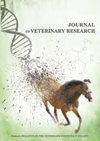Some aspects of the diagnosis and treatment of eosinophilic granuloma in cats
IF 1.3
3区 农林科学
Q2 VETERINARY SCIENCES
引用次数: 0
Abstract
Abstract Introduction Eosinophils represent the most active cells in mammals that show protective and assistive activity in the host immune defence against helminth parasites. These cells are also responsible for the reduction of allergic and inflammatory reactions. The eosinophils play a key role in allergic reactions by secretion of different chemical molecules leading to swelling, lesions and granuloma onset. Material and Methods The study was carried out on 30 cats with inflammatory skin lesions. The cats ranged in age from seven months to 13 years, and had an average age of three years. The research methodology included information on the disease, dermatological conclusions, concomitant disorders, medical and laboratory data and the treatment strategy. Results In total, 30 cats were diagnosed with eosinophilic granuloma complex. The distribution of lesions was 87.1% in the skin and 12.9% at the skin–mucosal junction. The lesions increased and decreased with the seasons of spring and summer, and the onset of the disease usually coincided with exposure to fleas. Conclusion Eosinophilic granuloma complex in cats is a serious pathology and frequently requires lifelong treatment, so it is important to diagnose it quickly and accurately to ensure optimal treatment of affected animals.猫嗜酸性肉芽肿的诊断和治疗的一些方面
嗜酸性粒细胞是哺乳动物中最活跃的细胞,在宿主对寄生虫的免疫防御中表现出保护和辅助作用。这些细胞也负责减少过敏和炎症反应。嗜酸性粒细胞在过敏反应中发挥关键作用,通过分泌不同的化学分子导致肿胀、病变和肉芽肿的发生。材料与方法选用30只皮肤炎性病变猫为实验对象。这些猫的年龄从7个月到13岁不等,平均年龄为3岁。研究方法包括疾病资料、皮肤病结论、伴随疾病、医疗和实验室数据以及治疗战略。结果30只猫被诊断为嗜酸性肉芽肿复合体。病变在皮肤的分布占87.1%,在皮肤粘膜交界处的分布占12.9%。病变随春夏季节的变化有增有减,发病时间多与接触跳蚤时间一致。结论猫嗜酸性肉芽肿是一种严重的疾病,往往需要终身治疗,快速准确的诊断对确保患病动物的最佳治疗至关重要。
本文章由计算机程序翻译,如有差异,请以英文原文为准。
求助全文
约1分钟内获得全文
求助全文
来源期刊

Journal of Veterinary Research
Veterinary-General Veterinary
CiteScore
0.90
自引率
5.60%
发文量
58
审稿时长
18 weeks
期刊介绍:
Journal of Veterinary Research (formerly Bulletin of the Veterinary Institute in Pulawy) is a quarterly that publishes original papers, review articles and short communications on bacteriology, virology, parasitology, immunology, molecular biology, pathology, toxicology, pharmacology, and biochemistry. The main emphasis is, however, on infectious diseases of animals, food safety and public health, and clinical sciences.
 求助内容:
求助内容: 应助结果提醒方式:
应助结果提醒方式:


